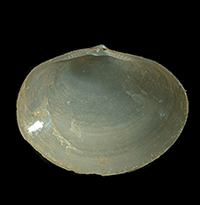|
< Previous family introduction |
|
|||||
 |
Family Sareptidae
|
|||||
|
The Sareptidae is similar to the Nuculidae in having a taxodont hinge, but the anatomy is more advanced in evolutionary terms. The gills are larger and there are separate inhalent and exhalent siphons, the inhalant one drawing in water for respiration and thereby assisting the labial palps in gathering food. The labial palps produce a sinus in the pallial line of some species. The shell is smooth and fragile, and in contrast to the Nuculidae, is not nacreous. The family was described by Huber (2010) as consisting of only about 10 mainly minute, ovate, deep-sea species. There is only one species recorded from NSW, exceptional in the family as it is of moderate size, up to 10 mm in length, and from moderate depth. It is recorded from NSW to South Australia; in NSW, it is known from depths of 75-176 m, but in South Australia it is recorded from 549 m. Family reference: The Australian species of the family were catalogued by Lamprell & Healy (1998). Coverage: The single NSW species is detailed here. Identification notes: The hinge of the single NSW species resembles that of the Nuculidae, but the shell is light in weight, translucent, and not nacreous internally. |